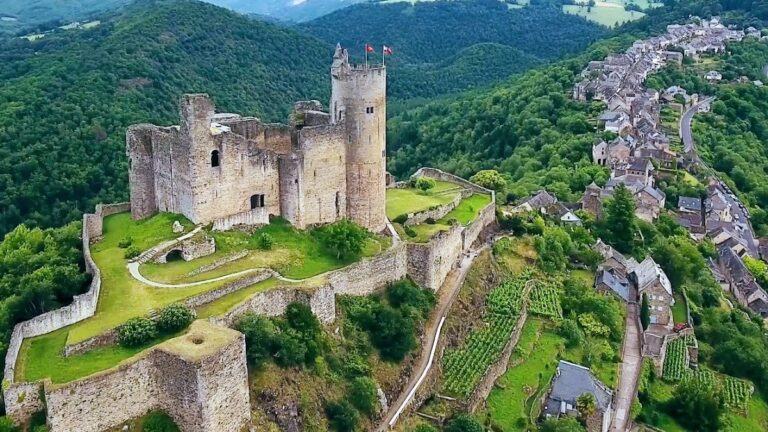Château de Penne: A Medieval Fortress in France
Visitor Information
Google Rating: 4.5
Popularity: Medium
Google Maps: View on Google Maps
Official Website: chateaudepenne.com
Country: France
Civilization: Unclassified
Remains: Military
History
The Château de Penne is a medieval fortress situated in the commune of Penne, France. It was built by the local ruling powers during the Middle Ages, with origins stretching back to the earlier Merovingian era.
The earliest recorded mention of the site dates from 825, when Pepin, King of Aquitaine, visited the castle. The first known lord associated with the fortress was Geoffroi, who took part in the First Crusade around 1096 alongside Raymond of Saint-Gilles, the Count of Toulouse. By the early 12th century, specifically in 1109, the castle became a fief under the Viscount of Albi, whose vassals included the lords of Albi, owing them allegiance. Around 1140, the influential Knights Templar came to hold properties within the region governed by Penne, although the castle itself was not officially owned by the order. Nevertheless, the local lords maintained close connections with the Templars, who helped guard the valley route leading to the nearby town of Montricoux.
In 1176, control of the castle shifted when the Counts of Toulouse seized it from the Trencavel family. The early 13th century brought turmoil as the Albigensian Crusade aimed to eliminate the Cathar heresy. In 1223, Amaury de Montfort, son of the crusading leader Simon de Montfort, captured the castle, although it was soon reclaimed by Cathar supporters. Following the decisive Treaty of Meaux in 1229, the Count of Toulouse was compelled to surrender the fortress to royal authorities. Despite strong resistance from local figures Olivier and Bernard de Penne, the castle was ultimately passed to Alphonse de Poitiers, who served as Count of Toulouse. Alphonse confirmed the privileges granted to the local inhabitants, enhanced the castle’s defenses, and relocated important county records to its premises. Upon his death in 1271, the château became part of the royal domain.
The turbulent period of the Hundred Years’ War saw the fortress change hands several times. In 1365, a Gascon captain named Mongat captured it on behalf of the English. The French reclaimed the castle in 1374, but the English occupied it again from 1384 until 1451. Afterward, the fortress declined in military importance. It was dismantled in 1586 and then left abandoned for over four centuries.
In the 20th century, the ruins gained protected status as a historic monument beginning on May 2, 1902. Restoration efforts began only in the early 1980s following its purchase by a lawyer named Me Breuil. Later, in 2006, architect Axel Letellier took ownership and initiated extensive conservation work, leading to renewed public access by 2010.
Remains
The Château de Penne occupies a striking position atop a naturally rugged rocky ridge that extends roughly 150 meters in length but narrows at points to as little as 8 meters wide, elevated more than 120 meters above a winding bend of the Aveyron River. The ridge’s uneven terrain provided strong natural defenses that were integrated into the castle’s design. The constructed area covers approximately 3,500 square meters, adapting to the complex contours of the site.
On the southern, lower side of the ridge lies a lower courtyard, a more modest enclosure surrounded by basic walls. This area serves as the outer defensive space and is the preliminary section visitors would cross before reaching the main castle. The fortress’s sole accessible gateway stands on the narrowest segment of the ridge, secured by a well-preserved gatehouse known as a châtelet. This stronghold includes two separate towers with different construction dates: a circular tower from the 13th century and a larger, uniquely shaped spur tower added in the 14th century. Together, these towers completely block passage along the ridge at this strategic choke point.
Within the gatehouse, there is a medieval defensive feature called an assommoir—a small room measuring about three meters square—designed to repel attackers attempting to breach the entrance. Nearby, the round tower’s ground floor contains an almost intact room equipped with an arrow slit, allowing defenders to fire upon enemies while remaining protected. The original masonry in this area has survived well enough to illustrate construction techniques of the period.
The castle’s dominant structure is the donjon, or keep, which rises above the rest of the complex. This heavily fortified tower was central to the castle’s defense and residence. Around the donjon once stood an irregular stone wall known as an enceinte, which was pierced at intervals with narrow openings for archers to shoot through. Today, only fragments of this curtain wall remain visible, offering glimpses into the castle’s former strength.
Below the fortress, the village of Penne lies nestled in a hollow at the base of the rocky ridge, emphasizing how the settlement and castle were closely linked both strategically and economically. Together, the castle and village formed a fortified community controlling the surrounding region for centuries.










